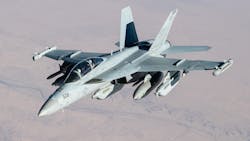Navy Eyes CAES for Jammer Low-Band Consolidation
The U.S. Navy has awarded a pre-production-phase contract to CAES for AN/ALQ-99 Low Band Consolidation (LBC) transmitters. The electronic-warfare (EW) system helps thwart the efforts of an adversary’s communications and radar systems.
A jammer with receiving antennas is mounted under wing fin tips and jammer antennas are mounted under wings that can receive, process, and jam high-frequency signals. The LBC modification includes many refinements, including adherence to reduced size, weight, and power (SWaP) requirements.
Mike Kahn, president and CEO of CAES, says, “We are proud to support the U.S. Navy with our engineering and manufacturing expertise to deliver high-performance advanced RF technologies. We have been investing to advance the system capabilities and SWaP for these applications and are excited to see it in use.”
The airborne electronic-warfare system was originally designed for Navy and Marine Corps vehicles such as the Navy’s EA-6B and EA-18G Growler aircraft.
The ALQ-99E version of the ALQ-99 tactical jamming system (TJS) is used on EF-111A Raven aircraft as stand-off jammers to escort other vehicles in transit. It's an improved version of the original system, overcoming faulty built-in-test (BIT) procedures.
CAES has been a major provider of the EW systems to the U.S. Navy and Royal Australian Air Force for several decades, having delivered more than 850 systems. The CAES jammer transmitters are designed, built, and tested for use in multiple-octave-frequency bandwidths to cover a wide range of spectrum. They have been developed for high reliability with low maintenance even when operating under hostile environmental conditions.
About the Author
Jack Browne
Technical Contributor
Jack Browne, Technical Contributor, has worked in technical publishing for over 30 years. He managed the content and production of three technical journals while at the American Institute of Physics, including Medical Physics and the Journal of Vacuum Science & Technology. He has been a Publisher and Editor for Penton Media, started the firm’s Wireless Symposium & Exhibition trade show in 1993, and currently serves as Technical Contributor for that company's Microwaves & RF magazine. Browne, who holds a BS in Mathematics from City College of New York and BA degrees in English and Philosophy from Fordham University, is a member of the IEEE.
